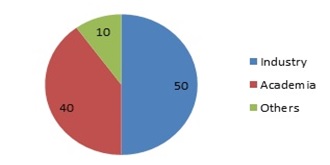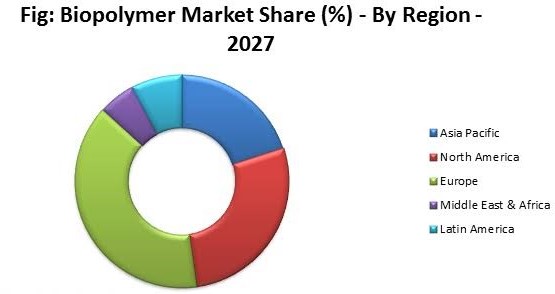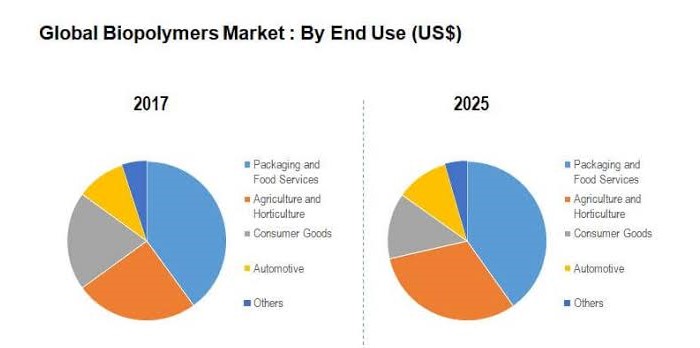Renowned Speakers

Francisco M Goycoolea
University of Leeds UK

Sumaya Yusuf Abbas
University of Warwick UK

Yakubu Muntaka Musah
University of Professional Studies Ghana

Katrien Bernaerts
1Maastricht University Netherlands

Barritault Denis
University Paris France

Ana Paula Testa Pezzin
University of Joinville Region (UNIVILLE) Brazil

Amit Jaiswal
Indian Institute of Technology Mandi, India

Amandine Flourat
Chaire ABI - AgroParisTech France
Recommended Global Chemical Engineering Webinars & Conferences
Europe & UK
Asia Pacific & Middle East
Canada
Biopolymers 2020
About Conference
We would like to invite all the participants from all over the world to attend "10th World Congress on Biopolymers & Bioplastics" during August 03-04, 2020 in Zurich, Switzerland which includes prompt keynote presentations, Oral talks, Poster presentations and Exhibitions.
Biopolymers are chain-like molecules made up of repeating chemical blocks and can be very long in length. Depending on the nature of the repeating unit they are made of polysaccharides, proteins of amino acids, and nucleic acids of nucleotides. The studies are more concerned to Green Composites, Biopolymer Feed Stock Challenges, Biofibers & Microbial Cellulose, Biomaterials and Bioplastics. Advanced studies are being made to improvise developments in Biopolymer Technology, Waste Management, pharmaceutical and biomedical applications, Biodegrade ability, and many more.
Young Scientist Benefits
- Our conferences provide best Platform for your research through oral presentations.
- Share the ideas with both eminent researchers and mentors.
- Young Scientist Award reorganization certificate and memento to the winners
- Young Scientists will get appropriate and timely information by this Forum.
- Platform for collaboration among young researchers for better development
- Award should motivate participants to strive to realize their full potential which could in turn be beneficial to the field as whole.
Deadline for Registrations:
- Platform for collaboration among young researchers for better development
- Till December 30, 2019 – $399
- Till January 30, 2020 – $499
- Till February 28, 2020 – $599
Over the past few years, global economic activities have increased a lot. This tremendous growth has raised serious problems about current important patterns of production and consumption. As the current society has increased its attention in understanding of the environmental aspects and its industrial practices, greater attention has been given to the concept of sustainable economic systems that rely on energy from undepletable source and materials. The use of Biologically derived Polymers become as an important component of this global world.
The history of Biopolymer is not a long one. Various reasons are associated with the research and development of Biopolymers. Use of Bioplastics will make a tremendous change and will help rid of the conventional plastics , which is a welcome change.
Biopolymers 2020 (WCBB-2020) offers a fantastic opportunity to meet and make new contacts in the field of Biopolymer, Bioplastic, Biocomposites, Biomaterials, Polymer Science, Biomedical and Tissue Engineering by providing collaboration spaces and break-out rooms with tea and lunch for delegates between sessions with invaluable networking time for you. It allows delegates to have issues addressed on Biomaterials and Biocomposites by recognized global experts who are up to date with the latest developments in the respective field and provide information on new techniques and technologies. This International Biopolymers and Bioplastics conference will feature renowned keynote speakers, plenary speeches, young research forum, poster presentations, technical workshops and career guidance sessions.
- Eminent Scientists of Polymer Science & Chemical Engineering, Green Chemistry
- Polymer Research Professors and research fellows
- Students from Material science, Polymer Science and Technology & Chemical Engineering
- Directors of Polymer Manufacturing companies, Green Chemicals Companies
- Biopolymer Engineers, Polymer Science Engineers & Chemical Engineers
- Members of different Bioploymer, Waste Management,Chemistry,Chemical Engineering associations.
Sessions and Tracks
With the successful journey of Biopolymer Congress 2019, London, UK, we are proud to announce that we have planned to continue its series at Zurich, Switzerland in August 03-04, 2020.
On this auspicious occasion, we invites all the participants across the globe to take part in the International Scientific Meet “10th World Congress on Biopolymers & Bioplastics” during August 03-04, 2020 Zurich, Switzerland, with the theme “Solution for current & future global challenges Biopolymers 2020”.
Right now we are in huge global crisis of Plastic Pollutions, Ocean Pollutions and these are the main reason for Climate Change. It’s already started to destroy our food chain. We have to act before it’s too late to save ourselves and our future.
Biopolymers 2020 offers a fantastic opportunity to meet and make new contacts in the field of Biomaterials, Polymer Science and engineering, by providing collaboration spaces and break-out rooms with tea and lunch for delegates between sessions with invaluable networking time for you. It allows delegates to have issues addressed on Bio materials by recognized global experts who are up to date with the latest developments in the Bio materials field and provide information on new techniques and technologies. This International Biopolymer Materials conference will feature renowned keynote speakers, plenary speeches, young research forum, poster presentations, technical workshops and career guidance sessions
Track 1: Biomaterials and Bioceomposits
Biomaterials are those materials which have been engineered to interact with biological systems for used in basically medical purpose. to augment or replace a natural function. As a science, it’s been about fifty years old. Study of biomaterials is called biomaterials science or biomaterials engineering. Many companies investing huge amounts of money for the development of new products. It holds within elements of medicine, biology, chemistry, tissue engineering and materials science.
A Biocomposite is a composite material composed of matrix (resin) and a reinforcement of natural fibers. These kinds of materials always providing biocompatibility. The matrix phase is formed by polymers derived from renewable and non-renewable resources. The matrix is important to protect the fibers from environmental degradation and mechanical damage, to hold the fibers together and to transfer the loads on it.
Biocomposites can be used alone, or as a complement to standard materials, such as carbon fiber.
Recommended
Biopolymer Conference | Bioplastic Conference | Biomaterials Conference | Sequencing Conference | Polymer Chemistry Conference | Microbial Natural Fiber Conference | Polymer Science Conference | Natural Fibers Conference | Biopolymer Conference 2019 | Bioplastic 2019 USA | Biopolymer Events | Biopolymer Summit | Biopolymer Expo | Polymer Chemistry Meetings | Polymers workshops and symposia
Polymers Societies and Associations
Europe: Royal Society of Chemistry; Society for Analytical Chemistry; Chemical Society; Royal Institute of Chemistry; Société chimique de France; Deutsche Chemische Gesellschaft zu Berlin; Danish Chemical Society; Society of Chemical Industry
USA: American Chemical Society; Society of Chemical Industry (American Section); Society of Chemical Manufacturers and Affiliates; Chemical Society of Peru; Canadian Society of Clinical Chemists; Chemical Society of Mexico ; Brazilian Chemical Society; Chemical Institute of Canada
Asia- Pacific: Chemical Society of Japan; Royal Australian Chemical Institute; Indian Chemical Society; Korean Chemical Society; Chemical Society of Pakistan; Iranian Chemists Association; Pan Africa Chemistry Network
Track 2: Advanced Polymers
Polylactide (PLA) the most promising one of Biopolymer these are a type of plastics which is being manufactured from petrochemicals, generated from sustainable feed stocks such as sugar, starch or Cellulose. Till date, the use of Biopolymer, includes the first generation PLA, has been limited by their Physical properties and relatively high cost to manufacture. Next generation Biopolymer, are the Plastics component fabrication, Polysaccharides second generation PLA, are to be cheaper and to improve their performance and a wide variety of application to capture an increasing share of the various markets for Biopolymer. Innovations has already achieved significant success with its early investments its $1.5m investment in obesity drug developer return up to $22m, following its sale for $100m in 2013, while the sale of a small molecule drug discovery company, resulted in Innovations realizing $9.5m, a 4.7 return on investment. In year 2015, Innovations invested $14.0m in 20 ventures, helping to launch three new companies.
Recommended
Biopolymer Conference | Bioplastic Conference | Biopolymers 2019 | Bioplastic 2019 | Best Biopolymer Conference | Best Bioplastic Conference | Polymer Conference | Chemistry Conference | Bioplastic Conference in UK | Biopolymer Conference in UK
Related Conference
9th World Congress on Biopolymer and Polymer Chemistry, May 13-14, 2019, Perth, Australia, 9th International Conference on Biopolymer and Polymer Sciences, November 19-21, 2018 Bucharest, Romania
Biopolymer Societies and Associations
Europe: Applied Chemical Engineering Society (ACES); Association for the Development of Biomaterials; French Chemical Society; Bio-Process Systems Alliance (BPSA); British Plastics Federation; European Council for Plasticizers and Intermediates; European Federation of Chemical Engineering;
USA: American Chemical Society; American Chemical Society; American Coatings Association; Brazilian Polymer Association; Division of Polymer Physics; American Chemical Society(ACS) ; American Physical Society Division of Polymer Physics (APS DPOLY);
Asia- Pacific: ASME BioProcessing Equipment; Australian Society of Biochemistry; Biochemistry Society; Bioenvironmental Polymer Society; IAENG Society of Chemical Engineering; Indian Institute of Chemical Engineers (IIChe);
Track 3: Bioplastics and its Applications
Bioplastic are plastics derived from renewable biomass sources, such as vegetable fats and oils, corn starch, or microbiota. Bioplastic can be made from agricultural by-products and also from used plastic bottles and other containers using microorganisms. Common plastics, such as fossil-fuel plastics are derived from petroleum or natural gas. Production of such plastics tends to require more fossil fuels and to produce more greenhouse gases than the production of biobased polymers (Bioplastic). Some, but not all, Bioplastic are designed to biodegrade. Biodegradable plastics can break down in either anaerobic or aerobic environments, depending on how they are manufactured. Bioplastic can be composed of starches, cellulose, Biopolymer, and a variety of other materials.
Related Conference
6th International Symposium Frontiers in Polymer Science, 05-08 May 2019, Budapest, Hungary, 35th INTERNATIONAL CONFERENCE of THE POLYMER PROCESSING SOCIETY, 26-30 May 2019, Cesme-Izmir, Turkey
Bioplastics Societies and Associations:
Europe: Society for Biomaterials; Society of Chemical Engineers; Society of Chemical Industry; Society of Polymer Science; The Chemical Engineering Graduate Student Association (ChEGSA); The polymer society; The Scandinavian Society for Biomaterials
USA: American Chemical Society; American Chemical Society; American Coatings Association; Brazilian Polymer Association; Division of Polymer Physics; American Chemical Society(ACS) ; American Physical Society Division of Polymer Physics (APS DPOLY);
Asia- Pacific: ASME BioProcessing Equipment; Australian Society of Biochemistry; Biochemistry Society; Bioenvironmental Polymer Society; IAENG Society of Chemical Engineering; Indian Institute of Chemical Engineers (IIChe);
Track 4: Ocean Plastics
Ocean plastic research is a relatively new field, the billions upon billions of items of plastic waste choking our oceans, lakes, and rivers and piling up on land is more than unsightly and harmful to plants and wildlife. About 8 million metric tons of plastic are thrown into the ocean annually. Of those, 236,000 tons are micro plastics– tiny pieces of broken-down plastic smaller than our little fingernail. There is more plastic than natural prey at the sea surface of the Great Pacific Garbage Patch, which means that organisms feeding at this area are likely to have plastic as a major component of their diets. For instance, sea turtles by-caught in fisheries operating within and around the patch can have up to 74% (by dry weight) of their diets composed of ocean plastics. By 2050 there will be more plastic in the oceans than there are fish (by weight).
Green Energy | Biotechnology | Green Composite | Biomaterials | Chitin and Chitosan | Applications of Biopolymer | Solar cells | Biochemistry | Biocomposites | Ocean Plastics | Tissue Engineering | Regenerative Medicine | Polymer Coatings | Biofilm | Monomers
Related Conference
11th Polyimides & High Performance Polymers Conference, 02-05 Jun 2019, Montpellier, France, 10th ECNP International Conference on Nanostructured Polymers and Nanocomposites, Oct 01-05 2018, San Sebastian, Spain
Ocean Plastics Societies and Associations
Europe: Society for Biomaterials; Society of Chemical Engineers; Society of Chemical Industry; Society of Polymer Science; The Chemical Engineering Graduate Student Association (ChEGSA); The polymer society; The Scandinavian Society for Biomaterials
USA: American Chemical Society; American Chemical Society; American Coatings Association; Brazilian Polymer Association; Division of Polymer Physics; American Chemical Society(ACS) ; American Physical Society Division of Polymer Physics (APS DPOLY);
Asia- Pacific: ASME BioProcessing Equipment; Australian Society of Biochemistry; Biochemistry Society; Bioenvironmental Polymer Society; IAENG Society of Chemical Engineering; Indian Institute of Chemical Engineers (IIChe);
Track 5: Natural polymers
Natural polymers include the RNA and DNA that are so important in genes and life processes. In fact, messenger RNA is what makes possible proteins, peptides, and enzymes. Enzymes help do the chemistry inside living organisms and peptides make up some of the more interesting structural components of skin, hair, and even the horns of rhinos. Other natural polymers include polysaccharides (sugar polymers), Cellulose, starch, lignin, chitin and polypeptides like silk, keratin, and hair. Natural rubber is, naturally a natural polymer also, made from just carbon and hydrogen. These materials and their derivatives offer a wide range of properties and applications. Natural polymers tend to be readily biodegradable, although the rate of degradation is generally inversely proportional to the extent of chemical modification. US companies demand for natural polymers is forecast to expand 6.9 % annually to $4.6 billion in 2016. Cellulose ethers, methyl cellulose, will remain the largest product segment. This study analyses the $3.3 billion US natural biopolymer industries. It presents historical demand data for the years 2001, 2006 and 2011, and forecasts for 2016 and 2021 by market.
Biocomposites meetings | Bioplastic meetings | London Conference | Biomaterials Conference | Biopolymer in London | Chemistry Conference UK | chemistry societies and associations | Biopolymer Associations and Societies | Bioplastic Summit | Biopolymer Expo
Related Conference
Gordon Research Seminar — Polymers, 08-09 Jun 2019, South Hadley, USA, Gordon Research Conference — Polymers, 09-14 Jun 2019, South Hadley, USA, 4th Annual Conference and Expo on Biomaterials, Feb 25-26, 2019, London, UK
Polymers Societies and Associations
Europe: Applied Chemical Engineering Society (ACES); Association for the Development of Biomaterials; French Chemical Society; Bio-Process Systems Alliance (BPSA); British Plastics Federation; European Council for Plasticizers and Intermediates; European Federation of Chemical Engineering;
USA: American Chemical Society; American Chemical Society; American Coatings Association; Brazilian Polymer Association; Division of Polymer Physics; American Chemical Society(ACS) ; American Physical Society Division of Polymer Physics (APS DPOLY);
Asia- Pacific: ASME BioProcessing Equipment; Australian Society of Biochemistry; Biochemistry Society; Bioenvironmental Polymer Society; IAENG Society of Chemical Engineering; Indian Institute of Chemical Engineers (IIChe);
Track 6: Green Composites in Biopolymer
Whole green composites are the composite materials that are made from both renewable resource based polymer (biopolymer) and bio-filler. Whole green composites are recyclable, renewable, triggered biodegradable and could reduce the dependency on the fossil fuel to a great extent when used in interior applications. Whole green composites could have major applications in automotive interiors, interior building applications and major packaging areas. Despite the large number of recent reviews on green composites defined as Biopolymer or bio-derived polymers reinforced with natural fibers for bioprocessing of materials, limited investigation has taken place into the most appropriate applications for these materials. Global composite materials industry reached $19.6B in 2011, marking an annual increase of 8.2% from 2010 and driven by recovering of majority of markets. Market value of end use products made with composites was $55.6B in 2011. North American composites industry accelerated by 9 % in 2014, Europe increased by 8%while Asia grew by 7% in 2015. By 2017, composite materials industry is expected to reach $ 29.9B (7% CAGR) while end products made with composite materials market value is expected to reach $85B Global Automotive composite materials market was estimated to be around $ 2.8 B in 2015, and forecast to reach $ 4.3 B by 2017 @ CAGR of approx. 7%.
Recommended
Biopolymer Conference 2019 | Bioplastic Conference 2019 | Biopolymer Conference Europe | Bioplastic Conference Europe | Biopolymer Conference USA | Bioplastic Conference USA | Chemical Engineering Conference | Biocomposites Conference in UK
Related Conference
8th International Conference and Exhibition on Biopolymer and Bioplastic, October 15-16, 2018 Las Vegas, Nevada, USA, The global plastics summit, October 30- Nov 01, 2018, Chicago, IL 36th INTERNATIONAL CONFERENCE of THE POLYMER PROCESSING SOCIETY, 31 May-04 Jun 2020, Montreal, Canada
Green Composites Societies and Associations:
Track 7: Synthetic polymers
Synthetic polymers are human-made polymers. They can be classified into four main categories: thermoplastics, thermosetting, elastomers, and synthetic fibers. They are commonly found in a variety of consumer products. synthetic polymers are used in home purpose and mainly in daily basic needs in house purpose. A wide variety of synthetic polymers are available with variations in main chain as well as side chains. The back bones of common synthetic polymers such as polythene, polystyrene and poly acrylates are made up of carbon-carbon bonds, whereas hetero chain polymers such as polyamides, polyesters, polyurethanes, polysulfides and polycarbonates have other elements (e.g. oxygen, sulfur, nitrogen) inserted along to the backbone. Also silicon forms similar materials without the need of carbon atoms, such as silicones through siloxane linkages; these compounds are thus said to be inorganic polymers. Coordination polymers may contain a range of metals in the backbone, with non-covalent bonding present.
Related Conference
Sixth International Symposium Frontiers in Polymer Science, 05-08 May 2019, Budapest, Hungary | Performance Polypropylene, May 14-15, 2019, Cologne, Germany
Recommended
Biopolymer Conference | Bioplastic Conference | Biomaterials Conference | Sequencing Conference | Polymer Chemistry Conference | Microbial Natural Fiber Conference | Polymer Science Conference | Natural Fibers Conference | Biopolymer Conference 2019 | Bioplastic 2019 USA | Biopolymer Events | Biopolymer Summit | Biopolymer Expo | Polymer Chemistry Meetings | Polymers workshops and symposia
Polymers Societies and Associations
Europe: Royal Society of Chemistry; Society for Analytical Chemistry; Chemical Society; Royal Institute of Chemistry; Société chimique de France; Deutsche Chemische Gesellschaft zu Berlin; Danish Chemical Society; Society of Chemical Industry
USA: American Chemical Society; Society of Chemical Industry (American Section); Society of Chemical Manufacturers and Affiliates; Chemical Society of Peru; Canadian Society of Clinical Chemists; Chemical Society of Mexico ; Brazilian Chemical Society; Chemical Institute of Canada
Asia- Pacific: Chemical Society of Japan; Royal Australian Chemical Institute; Indian Chemical Society; Korean Chemical Society; Chemical Society of Pakistan; Iranian Chemists Association; Pan Africa Chemistry Network
Track 8: Organic polymers
Organic polymers are macromolecules composed of many repeating monomer units. Both synthetic and natural polymers play a crucial role in everyday life. Polysaccharides, polypeptides, and polynucleotides are the main types of biopolymers in living cells. These polymers are synthesized by enzyme-mediated processes in cells. In general, synthetic polymers are derived from monomers that contain either a multiple bond, or two or more functional groups, or a three-to seven- membered ring.. The chemical properties of the polymers are derived from their monomer units, while the physical properties of polymers are different. Polymers, depending on their physical properties, are characterised as thermoplastics, thermo sets, elastomers and fibres. Organic polymers have wide variety of uses, for example: polystyrene resins are used in the production of home electronics and appliances; nylon-6 is used in textile and plastic industries. Organic polymers such as polyethylene terephthalate are in the manufacture of popular PET bottles. Others such as neoprene are used in shoe soles and wet suits, polyvinyl chloride in pipes and Teflon in non-stick pans.
Related Conference
Sixth International Symposium Frontiers in Polymer Science, 05-08 May 2019, Budapest, Hungary | Performance Polypropylene, May 14-15, 2019, Cologne, Germany
Recommended
Biopolymer Conference | Bioplastic Conference | Biomaterials Conference | Sequencing Conference | Polymer Chemistry Conference | Microbial Natural Fiber Conference | Polymer Science Conference | Natural Fibers Conference | Biopolymer Conference 2019 | Bioplastic 2019 USA | Biopolymer Events | Biopolymer Summit | Biopolymer Expo | Polymer Chemistry Meetings | Polymers workshops and symposia
Polymers Societies and Associations
Europe: Royal Society of Chemistry; Society for Analytical Chemistry; Chemical Society; Royal Institute of Chemistry; Société chimique de France; Deutsche Chemische Gesellschaft zu Berlin; Danish Chemical Society; Society of Chemical Industry
USA: American Chemical Society; Society of Chemical Industry (American Section); Society of Chemical Manufacturers and Affiliates; Chemical Society of Peru; Canadian Society of Clinical Chemists; Chemical Society of Mexico ; Brazilian Chemical Society; Chemical Institute of Canada
Asia- Pacific: Chemical Society of Japan; Royal Australian Chemical Institute; Indian Chemical Society; Korean Chemical Society; Chemical Society of Pakistan; Iranian Chemists Association; Pan Africa Chemistry Network
Track 9:Linear polymers:
Linear Polymers are polymers in which monomeric units are linked together to form linear chains. These linear polymers are well packed and have high magnitude of intermolecular forces of attraction and therefore have high densities, high tensile strength and high melting points. Linear polymers have a specific set of physicochemical and mechanical properties. The most important properties are the ability to form highstrength anisotropic, highly oriented fibers and films; the capacity for large, slowly developing reversible deformations; the ability to swell in the hyperelastic state before dissolving; and the high viscosity of solutions. This set of properties results from the high molecular weight, the chain structure, and the flexibility of the macromolecules. In the transition from linear to branched, sparse threedimensional networks, and finally to dense cross linked structures, these properties become decreasingly pronounced. Strongly crosslinked polymers are insoluble, infusible, and incapable of hyperelastic deformations.
Related Conference
Sixth International Symposium Frontiers in Polymer Science, 05-08 May 2019, Budapest, Hungary | Performance Polypropylene, May 14-15, 2019, Cologne, Germany
Recommended
Biopolymer Conference | Bioplastic Conference | Biomaterials Conference | Sequencing Conference | Polymer Chemistry Conference | Microbial Natural Fiber Conference | Polymer Science Conference | Natural Fibers Conference | Biopolymer Conference 2019 | Bioplastic 2019 USA | Biopolymer Events | Biopolymer Summit | Biopolymer Expo | Polymer Chemistry Meetings | Polymers workshops and symposia
Polymers Societies and Associations
Europe: Royal Society of Chemistry; Society for Analytical Chemistry; Chemical Society; Royal Institute of Chemistry; Société chimique de France; Deutsche Chemische Gesellschaft zu Berlin; Danish Chemical Society; Society of Chemical Industry
USA: American Chemical Society; Society of Chemical Industry (American Section); Society of Chemical Manufacturers and Affiliates; Chemical Society of Peru; Canadian Society of Clinical Chemists; Chemical Society of Mexico ; Brazilian Chemical Society; Chemical Institute of Canada
Asia- Pacific: Chemical Society of Japan; Royal Australian Chemical Institute; Indian Chemical Society; Korean Chemical Society; Chemical Society of Pakistan; Iranian Chemists Association; Pan Africa Chemistry Network
Track 10:Cross linked polymers:
cross-liked polymers are a kind of polymer, whose molecular chains are binded with each other. This bond is can either be a chemical or a physical one, but usually when we talk about a cross-linked polymer, we mean chemical bonds.
Cross-linked polymers, such as thermosets and elastomers, behave completely different than their counterparts, thermoplastic polymers. In cross-linked systems, the mechanical behavior is also best reflected by the plot of the shear modulus versus temperature. Figure 1 compares the shear modulus between highly cross-linked, coarsely cross-linked and uncross-linked polymers. The coarse cross-linked system, typical of elastomers, has a low modulus above the glass transition temperature. The glass transition temperature of these materials is usually below -50 °C, so they are soft and flexible at room temperature. In contrast, highly crosslinked systems, typical in thermosets, show a smaller decrease in stiffness as the material is raised above the glass transition temperature; the decrease in properties becomes smaller as the degree of cross-linking increases .crossed linked polymers are usually contains rubber in terms of flexibility. One of the most important properties of Cross-linked Polymers is that, they are thermosetting, which means, they cannot be melted or dissolved. So it can be harder for us to process this kind of polymer. They are considered as ideal dressings as they clean, rehydrate dry and necrotic tissues and initiate autolytic debridement. It has been reported that they promote moist healing and are used to treat venous leg ulcers.
Related Conference
Sixth International Symposium Frontiers in Polymer Science, 05-08 May 2019, Budapest, Hungary | Performance Polypropylene, May 14-15, 2019, Cologne, Germany
Recommended
Biopolymer Conference | Bioplastic Conference | Biomaterials Conference | Sequencing Conference | Polymer Chemistry Conference | Microbial Natural Fiber Conference | Polymer Science Conference | Natural Fibers Conference | Biopolymer Conference 2019 | Bioplastic 2019 USA | Biopolymer Events | Biopolymer Summit | Biopolymer Expo | Polymer Chemistry Meetings | Polymers workshops and symposia
Polymers Societies and Associations
Europe: Royal Society of Chemistry; Society for Analytical Chemistry; Chemical Society; Royal Institute of Chemistry; Société chimique de France; Deutsche Chemische Gesellschaft zu Berlin; Danish Chemical Society; Society of Chemical Industry
USA: American Chemical Society; Society of Chemical Industry (American Section); Society of Chemical Manufacturers and Affiliates; Chemical Society of Peru; Canadian Society of Clinical Chemists; Chemical Society of Mexico ; Brazilian Chemical Society; Chemical Institute of Canada
Asia- Pacific: Chemical Society of Japan; Royal Australian Chemical Institute; Indian Chemical Society; Korean Chemical Society; Chemical Society of Pakistan; Iranian Chemists Association; Pan Africa Chemistry Network
Track11:Amorphous polymers:
Amorphous polymers may exist in three physical states: vitreous, hyperelastic, and viscous-flow. Polymers with a low temperature (below room temperature) for the transition from the vitreous to the hyperelastic state are called elastomers, and polymers with high transition temperatures are called plastics. The properties of polymers vary within a broad range, depending on chemical composition and the structure and mutual arrangement of the macromolecules. Thus 1,4-cis polybutadiene, which is composed of flexible hydrocarbon chains, is elastic at about 20°C and undergoes transition to the vitreous state at 60°C. Polymethyl methacrylate, which is composed of more rigid chains, is a hard, vitreous substance at about 20°C and undergoes transition to the hyperelastic state only at 100°C. Cellulose, which is a polymer with very rigid chains linked by intermolecular hydrogen bonds, cannot exist at all in the hyperelastic state at temperatures below its decomposition point. Great differences may be seen in the properties of polymers even if the differences in the macromolecular structures are not great at first glance. Thus, stereoregular polystyrene is a crystalline substance with a melting point of about 235°C, whereas its nonstereoregular (atactic) analogue is completely incapable of crystallizing and softens at about 80°C.
Related Conference
Sixth International Symposium Frontiers in Polymer Science, 05-08 May 2019, Budapest, Hungary | Performance Polypropylene, May 14-15, 2019, Cologne, Germany
Recommended
Biopolymer Conference | Bioplastic Conference | Biomaterials Conference | Sequencing Conference | Polymer Chemistry Conference | Microbial Natural Fiber Conference | Polymer Science Conference | Natural Fibers Conference | Biopolymer Conference 2019 | Bioplastic 2019 USA | Biopolymer Events | Biopolymer Summit | Biopolymer Expo | Polymer Chemistry Meetings | Polymers workshops and symposia
Polymers Societies and Associations
Europe: Royal Society of Chemistry; Society for Analytical Chemistry; Chemical Society; Royal Institute of Chemistry; Société chimique de France; Deutsche Chemische Gesellschaft zu Berlin; Danish Chemical Society; Society of Chemical Industry
USA: American Chemical Society; Society of Chemical Industry (American Section); Society of Chemical Manufacturers and Affiliates; Chemical Society of Peru; Canadian Society of Clinical Chemists; Chemical Society of Mexico ; Brazilian Chemical Society; Chemical Institute of Canada
Asia- Pacific: Chemical Society of Japan; Royal Australian Chemical Institute; Indian Chemical Society; Korean Chemical Society; Chemical Society of Pakistan; Iranian Chemists Association; Pan Africa Chemistry Network
Track 12:Natural polymers
Natural polymers include the RNA and DNA that are so important in genes and life processes. In fact, messenger RNA is what makes possible proteins, peptides, and enzymes. Enzymes help do the chemistry inside living organisms and peptides make up some of the more interesting structural components of skin, hair, and even the horns of rhinos. Other natural polymers include polysaccharides (sugar polymers), Cellulose, starch, lignin, chitin and polypeptides like silk, keratin, and hair. Natural rubber is, naturally a natural polymer also, made from just carbon and hydrogen. These materials and their derivatives offer a wide range of properties and applications. Natural polymers tend to be readily biodegradable, although the rate of degradation is generally inversely proportional to the extent of chemical modification. US companies demand for natural polymers is forecast to expand 6.9 % annually to $4.6 billion in 2016. Cellulose ethers, methyl cellulose, will remain the largest product segment. This study analyses the $3.3 billion US natural biopolymer industries. It presents historical demand data for the years 2001, 2006 and 2011, and forecasts for 2016 and 2021 by market.
Related Conference
Sixth International Symposium Frontiers in Polymer Science, 05-08 May 2019, Budapest, Hungary | Performance Polypropylene, May 14-15, 2019, Cologne, Germany
Recommended
Biopolymer Conference | Bioplastic Conference | Biomaterials Conference | Sequencing Conference | Polymer Chemistry Conference | Microbial Natural Fiber Conference | Polymer Science Conference | Natural Fibers Conference | Biopolymer Conference 2019 | Bioplastic 2019 USA | Biopolymer Events | Biopolymer Summit | Biopolymer Expo | Polymer Chemistry Meetings | Polymers workshops and symposia
Polymers Societies and Associations
Europe: Royal Society of Chemistry; Society for Analytical Chemistry; Chemical Society; Royal Institute of Chemistry; Société chimique de France; Deutsche Chemische Gesellschaft zu Berlin; Danish Chemical Society; Society of Chemical Industry
USA: American Chemical Society; Society of Chemical Industry (American Section); Society of Chemical Manufacturers and Affiliates; Chemical Society of Peru; Canadian Society of Clinical Chemists; Chemical Society of Mexico ; Brazilian Chemical Society; Chemical Institute of Canada
Asia- Pacific: Chemical Society of Japan; Royal Australian Chemical Institute; Indian Chemical Society; Korean Chemical Society; Chemical Society of Pakistan; Iranian Chemists Association; Pan Africa Chemistry Network
Polymer Nano composites (PNC) are made of a polymers or copolymers having nanoparticles or Nano fillers dispersed in the polymer matrix. The plastic used for food packaging and non-food applications is non-biodegradable, and also of valuable and scarce non-renewable resources like petroleum. With the current research on exploring the alternatives to petrol and priority on reduced environmental impact, research is increased in development of biodegradable packaging from biopolymer-based materials. A biomaterial is a surface, or construct that interacts with biological systems. These biomaterials are about fifty years old. The study of such materials is called biomaterials science. It has been seen a strong growth over its past period, were many companies have been investing large amounts in the development of new products. Biomaterials science is the elements of medicine, biology, chemistry, tissue engineering and materials science. The Biomaterial market over the forecast period of 2016-2021 market for biomaterials is likely to predict to USD 70.90 Billion in 2012 and is steady to grow at a CAGR of 16.0% from 2016 to 2021 to reach USD 149.17 Billion by 2021.
Recommended
Middle East Polymer Conference | Polymer Conference Asia | Polymer Science Meetings Asia | Polymer Conference Europe | Polymer societies and Associations | Biocomposites Conference | Polymer Scientists | Biocomposites Researchers
Related Conference
International Conference on Biopolymer & Bioplastic, March 04-06, 2019, Baltimore, USA, bio!PAC conference on biobased packaging, May 28-29, 2019, Dusseldorf, Germany
Biopolymer Societies and Associations:
Europe: European Polymer Federation; European Society for Biomaterials; Federation of European Biochemical Societies; Federation Of European Materials Societies; Federation of European Materials Society; Belgian Polymer Group (BPG); Polymer processing society;
USA: American Chemical Society; American Chemical Society; American Coatings Association; Brazilian Polymer Association; Division of Polymer Physics; American Chemical Society(ACS) ; American Physical Society Division of Polymer Physics (APS DPOLY);
Asia- Pacific: ASME BioProcessing Equipment; Australian Society of Biochemistry; Biochemistry Society; Bioenvironmental Polymer Society; IAENG Society of Chemical Engineering; Indian Institute of Chemical Engineers (IIChe);
Track 9: Biopolymer for Tissue Engineering and Regenerative Medicine
Tissue engineering is the immense area of research in recent years because of its vast potential in the repair or replacement of impaired tissues and organs. The present research will focus on scaffolds as they are one of the three most important factors, including seed cells, growth hormones and scaffolds in tissue engineering. Among the polymers used in tissue engineering, polyhydroxy esters (such as PLA, PGA, and PLGA) have extensive attention for a variety of biomedical applications. Besides, PCL has been widely used as a tissue engineering scaffold. Scaffolds have been used for tissue engineering such as bone, cartilage, ligament, skin, vascular tissues, neural tissues, and skeletal muscle and as vehicle for the delivery of drugs, proteins, and DNA. The worldwide market for tissue engineering and regeneration products is expected to reach USD 11.5 billion by 2022.
Recommended
Europe Conference | Natural Fiber Conference Japan | Natural Fiber Conference Europe | Natural Fiber Conference Middle East | Biocomposites Conference in USA | Biofibers | Bioplastic Expo | Nanopolymers | Natural polymers
Related Conference
13th International Workshop on Polymer Reaction Engineering, 11-14 Jun 2019, Hamburg, Germany, 26th International Symposium: Synthesis in Organic Chemistry, 15-18 Jul 2019, Cambridge, United Kingdom
Tissue Engineering Societies and Associations:
Europe: Applied Chemical Engineering Society (ACES); Association for the Development of Biomaterials; French Chemical Society; Bio-Process Systems Alliance (BPSA); British Plastics Federation; European Council for Plasticizers and Intermediates; European Federation of Chemical Engineering;
USA: American Chemical Society; American Chemical Society; American Coatings Association; Brazilian Polymer Association; Division of Polymer Physics; American Chemical Society(ACS) ; American Physical Society Division of Polymer Physics (APS DPOLY);
Asia- Pacific: ASME BioProcessing Equipment; Australian Society of Biochemistry; Biochemistry Society; Bioenvironmental Polymer Society; IAENG Society of Chemical Engineering; Indian Institute of Chemical Engineers (IIChe);
Track 10: Biopolymer in Biofibers & Microbial Cellulose
Cellulose the most generous natural biopolymer on the earth, synthesized by plants, algae and also some species of bacteria and microorganisms. The Plant derivative cellulose and Black Carbon (BC) have the same chemical composition but differ in structure and physical properties. The BC network structure comprises cellulose Nano fibrils 3-8 nm in diameter, and the crystalline regions are been the normal cellulose I. The properties such as the Nano metric structure, unique physical and mechanical properties together produce higher purity that lead to great number of commercial products. Lignocellulosic agricultural byproducts are an extensive and cheap source for cellulose fibers. Agro-based Biofibers have the architecture, properties and design that make them suitable for use as composite, textile, pulp and paper manufacture. In addition, Biofibers can be used to produce biofuel, chemicals, enzymes and food. The global bio-fiber composites market reached $ 3.8 billion in 2016, with CAGR of 10% in last three years. Among them, the automotive and construction industry were the greater application segments. By 2023, this natural fiber composite market is expected to reach $7.6 billion (7.9% CAGR).
Recommended
Biopolymer Symposium | Bioplastic Symposium | Biomaterials Symposium | Biocomposites Symposium | Polymer Symposium | Plastics Symposium | Euro Biopolymer | Euro Bioplastic | Euro Polymers | Euro Plastics | Nanostructured Polymers | Research Seminar
Related Conference
4th Organic Chemistry Congress with International Participation, October 04-07, 2018, Antalya , Turkey, 7th International Conference on Polyolefin Characterization, October 21-24 2018, Houston, TX, United States International Rubber Conference, 10-12 Sep 2019, London, United Kingdom
Biopolymer Societies and Associations:
Europe: Applied Chemical Engineering Society (ACES); Association for the Development of Biomaterials; French Chemical Society; Bio-Process Systems Alliance (BPSA); British Plastics Federation; European Council for Plasticizers and Intermediates; European Federation of Chemical Engineering;
USA: American Chemical Society; American Chemical Society; American Coatings Association; Brazilian Polymer Association; Division of Polymer Physics; American Chemical Society(ACS) ; American Physical Society Division of Polymer Physics (APS DPOLY);
Asia- Pacific: ASME BioProcessing Equipment; Australian Society of Biochemistry; Biochemistry Society; Bioenvironmental Polymer Society; IAENG Society of Chemical Engineering; Indian Institute of Chemical Engineers (IIChe);
Track 11: Biodegradable polymers
Biodegradable polymers are a specific type of polymer that breaks down after its intended purpose to result in natural by-products such as gases (CO2, N2), water, biomass, and inorganic salts. These are found both naturally and synthetically made, and largely consist of ester, amide, and ether functional groups. Their properties and breakdown mechanism are determined by their exact structure. These polymers are often synthesized by condensation reactions, ring opening polymerization, and metal catalysts. There are vast examples and applications of biodegradable polymers.
Recommended
Biopolymer Exhibition | Bioplastic Exhibition | Global Plastics Summit | Polymer Reaction engineering | Organic Chemistry | Biobased Products | 3D Printing | European Polymer Congress | Biopolymer Congress | Bioplastic Congress | European Plastic Congress
Related Conference
Polymers + 3D, Nov 01-02, 2018, Houston, Texas, United States, Emerging Polymer Technologies Summit, Nov 04-08 2018, Hanoi, Vietnam
Biodegradable polymer Societies and Associations:
Europe: Applied Chemical Engineering Society (ACES); Association for the Development of Biomaterials; French Chemical Society; Bio-Process Systems Alliance (BPSA); British Plastics Federation; European Council for Plasticizers and Intermediates; European Federation of Chemical Engineering;
USA: American Chemical Society; American Chemical Society; American Coatings Association; Brazilian Polymer Association; Division of Polymer Physics; American Chemical Society(ACS) ; American Physical Society Division of Polymer Physics (APS DPOLY);
Asia- Pacific: ASME BioProcessing Equipment; Australian Society of Biochemistry; Biochemistry Society; Bioenvironmental Polymer Society; IAENG Society of Chemical Engineering; Indian Institute of Chemical Engineers (IIChe);
Track 12: Polymer Processing and Modeling
Polymer processing is the technique of converting raw polymeric materials into completed products having desirable shape, microstructures and properties. The raw form of polymers is available initially as pellets which are heated to its glass transition temperature to form into a viscous fluid. The fluid is then subjected to moulding and rapid solidification by cooling which results in the development of the required shape and microstructures. This method has been a standard since for thermoplastic processing since the 1960s. Thermosetting plastics utilize a similar processing method but with additives and cross-linking agents. The crosslinking formed after cooling are and irreversible and re-heating will not be effective in liquefying the polymers.
Polymers modeling process has become prominent since the last decade, especially for processing soft materials. New sampling methods are developed to increase the exploration of configuration space, which has been still continues to be of paramount importance in the determining the properties of polymeric materials. The time duration and scaling issues are being addressed with new coarse-grained methods, while more traditional methods are being applied in increasing chemical complexity and reality.
Recommended
Europe Conference | Natural Fiber Conference Japan | Natural Fiber Conference Europe | Natural Fiber Conference Middle East | Biocomposites Conference in USA | Biofibers | Bioplastic Expo | Nanopolymers | Natural polymers
Related Conference
Polymer Processing Society Americas Regional Conference, Nov 05-09 2018, Boston , United States, 47th National Symposium of the French Group of Polymers Studies and Applications, 26-29 Nov 2018, Toulouse , France
Biomedical Societies and Associations:
Europe: European Polymer Federation; European Society for Biomaterials; Federation of European Biochemical Societies; Federation Of European Materials Societies; Federation of European Materials Society; Belgian Polymer Group (BPG); Polymer processing society;
USA: American Chemical Society; American Chemical Society; American Coatings Association; Brazilian Polymer Association; Division of Polymer Physics; American Chemical Society(ACS) ; American Physical Society Division of Polymer Physics (APS DPOLY);
Asia- Pacific: ASME BioProcessing Equipment; Australian Society of Biochemistry; Biochemistry Society; Bioenvironmental Polymer Society; IAENG Society of Chemical Engineering; Indian Institute of Chemical Engineers (IIChe);
Track 13: Synthetic polymers, Nanopolymers and Nanotechnology
Synthetic polymers are man-made polymers. For utility, it can be classified into four main categories: thermoplastics, thermosets, elastomers and synthetic fibers. These polymers are commonly found in a variety of consumer products such as money, glue, etc.
In the field of Polymer science and nanotechnology, Nano polymers and nanoclays have gained massive interests from researchers and in recent literatures. Nanotechnology is included in the most popular areas for today’s research and development and basically in all areas of technical disciplines. This also includes polymer science, which includes an wide range of sub-fields. Nanopolymers are used in microelectronics and the micro-devices are now below 100 nm. Both Nanopolymers and Polymer based Biomaterials are used for drug delivery, miniemulsion particles, fuel cell electrode polymer bound catalysts, polymer films, inprint lithography, electrospun nanofibers and polymer blends. Nanopolymers include various physical properties that are applied in composite reinforcement for imparting abilities to the composite such as barrier strength, electro-optical properties, flame resistance. Recent enthusiasm in polymer matrix based nanocomposites was emerged initially with interesting observations involving exfoliated clay and more recent studies with carbon nanotubes, carbon nanofibers, exfoliated graphite (graphene), nanocrystalline metals and a host of additional nanoscale inorganic filler or fiber modifications.
Recommended
Green Energy | Biotechnology | Green Composite | Biomaterials | Chitin and Chitosan | Applications of Biopolymer | Solar cells | Biochemistry | Biocomposites | Ocean Plastics | Tissue Engineering | Regenerative Medicine | Polymer Coatings | Biofilm | Monomers
Related Conference
The 12th SPSJ International Polymer Conference, 04-07 Dec 2018, Hiroshima, Japan, International Conference On Phosphorus, Boron and Silicon 2018, 10-12 Dec 2018, Barcelona, Spain
Bioinformatics Societies and Associations:
Europe: Applied Chemical Engineering Society (ACES); Association for the Development of Biomaterials; French Chemical Society; Bio-Process Systems Alliance (BPSA); British Plastics Federation; European Council for Plasticizers and Intermediates; European Federation of Chemical Engineering;
USA: American Chemical Society; American Chemical Society; American Coatings Association; Brazilian Polymer Association; Division of Polymer Physics; American Chemical Society(ACS) ; American Physical Society Division of Polymer Physics (APS DPOLY);
Asia- Pacific: ASME BioProcessing Equipment; Australian Society of Biochemistry; Biochemistry Society; Bioenvironmental Polymer Society; IAENG Society of Chemical Engineering; Indian Institute of Chemical Engineers (IIChe);
Track 14: Recycling & Waste management of Biopolymer
Biobased polymers lead not only on the raw materials side but also on the other side through certain promising end-of-life (EOL) options. Exclusively waste disposal with energy recovery has an added advantage, which lies in benefiting carbon neutral energy while allowing multiple uses of possible recycling. The recent commission after research said that all of the composts contain biodegradable polymers materials could be classified using a risk assessment system at a higher toxicity position. Biodegradable polymers waste can serve for aerobic degradation, composting, or anaerobic digestion. When Biopolymer are propagated or digested, their individual elements are recycled naturally in particular in their carbon and hydrogen content. The greater segment of the market, packaging, is expected to reach nearly $980 billion in 2022. The second-largest market segment, made up of fibers/fabrics is expected to increase in volume from an estimated 435 million pounds in 2016 to USD 93.27 billion by 2025, growing at a CAGR of 12.1%.
Recommended
Biocomposites meetings | Bioplastic meetings | London Conference | Biomaterials Conference | Biopolymer in London | Chemistry Conference UK | chemistry societies and associations | Biopolymer Associations and Societies | Bioplastic Summit | Biopolymer Expo
Related Conference
The International Conference on Advanced and Applied Petroleum, Petrochemicals, and Polymers, 18-20 Dec 2018, Bangkok, Thailand, Maximising Propylene Yields, 23-24 Jan 2019, Barcelona, Spain
Recycling Societies and Associations:
Europe: Society for Biomaterials; Society of Chemical Engineers; Society of Chemical Industry; Society of Polymer Science; The Chemical Engineering Graduate Student Association (ChEGSA); The polymer society; The Scandinavian Society for Biomaterials
USA: American Chemical Society; American Chemical Society; American Coatings Association; Brazilian Polymer Association; Division of Polymer Physics; American Chemical Society(ACS) ; American Physical Society Division of Polymer Physics (APS DPOLY);
Asia- Pacific: ASME BioProcessing Equipment; Australian Society of Biochemistry; Biochemistry Society; Bioenvironmental Polymer Society; IAENG Society of Chemical Engineering; Indian Institute of Chemical Engineers (IIChe);
Track 15: Biopolymer Feed Stock Challenges & Opportunities
Bio related products can restore petroleum-related products, new methodologies, where various types of lignocellulosic biomass experience bioprocessing to commercially important products, must be devised. A relatively low value lignocellulosic biomass that could be used to produce bio based co-products is grass. Currently, many grasses are largely took the advantage for cropping by livestock or harvested as hay. To exploit this opportunity, the feasibility of using microbial bioconversion for the production of chemicals and polysaccharide gums from the fermentable sugars present in hydrolysates of various grass species. The production of 2.5 g/l was obtained when the cells were grown on medium containing 70 mM sucrose and 0.2% (w/v) Casamino Acids. It enriched medium is maximum Biopolymer production of up to 3.4 g/laws was obtained.
Recommended
Top Biopolymer Conference | Top Bioplastic Conference | Biopolymer Events | Biochemistry Conference | Biopolymer Conference Europe | International Conference on Biopolymer | International Conference on Bioplastic | Biopolymer meetings | Biopolymer Summit
Related Conference
Gordon Research Seminar — Bioinorganic Chemistry, 31 Jan- 03 Feb 2019, Ventura, CA, United States, 9th Biennial Australian Colloid and Interface Symposium 03-07 Feb 2019, Hobart, Australia
Biopolymer Societies and Associations:
Europe: European Polymer Federation; European Society for Biomaterials; Federation of European Biochemical Societies; Federation Of European Materials Societies; Federation of European Materials Society; Belgian Polymer Group (BPG); Polymer processing society;
USA: American Chemical Society; American Chemical Society; American Coatings Association; Brazilian Polymer Association; Division of Polymer Physics; American Chemical Society(ACS) ; American Physical Society Division of Polymer Physics (APS DPOLY);
Asia- Pacific: ASME BioProcessing Equipment; Australian Society of Biochemistry; Biochemistry Society; Bioenvironmental Polymer Society; IAENG Society of Chemical Engineering; Indian Institute of Chemical Engineers (IIChe);
Track 16: Future & Scope of Biopolymer
Futures of Biopolymer demand the manufacturer for new materials is overwhelming. However the cost-effectiveness of the materials must progress as they are contributed specifically for sustainable development. Applications by the use of new materials should utilize the properties of these polymers, and the products should be developed based on those properties. They are onset to arrive as a result to be more responsible in taking care of the world we live in. Thus, the recent development for the bio-based products rather than petroleum or natural gas based products. The use of Biopolymer could markedly increase as more reliable form for the development and the cost to manufacture these Bioplastic continues to go fall. Bioplastic can be replaced with conventional plastics in the field of application which can be used in various categories such as food packaging, plastic plates, cups, cutlery, plastic storage bags, storage containers or other plastic or composite materials items you are buying and therefore can help in making environment sustainable. Bio-based polymers are adjacent to the conventional polymers than ever before. Now a day, biobased polymers are commonly found in various applications from commodity to hi-tech applications due to advance research development in biotechnology and public awareness.
Recommended
Biopolymer Conference | Bioplastic Conference | Biopolymers 2019 | Bioplastic 2019 | Best Biopolymer Conference | Best Bioplastic Conference | Polymer Conference | Chemistry Conference | Bioplastic Conference in UK | Biopolymer Conference in UK
Related Conference
Premier Symposium International de Chimie des Polymères & Applications, 23-25 Feb 2019, Wilaya de Bechar, Algeria, SMALP 2019 Meeting in Utrecht, 26 Apr 2019, Utrecht , Netherlands
Biopolymer Societies and Associations:
Europe: Society for Biomaterials; Society of Chemical Engineers; Society of Chemical Industry; Society of Polymer Science; The Chemical Engineering Graduate Student Association (ChEGSA); The polymer society; The Scandinavian Society for Biomaterials
USA: American Chemical Society; American Chemical Society; American Coatings Association; Brazilian Polymer Association; Division of Polymer Physics; American Chemical Society(ACS) ; American Physical Society Division of Polymer Physics (APS DPOLY);
Asia- Pacific: ASME BioProcessing Equipment; Australian Society of Biochemistry; Biochemistry Society; Bioenvironmental Polymer Society; IAENG Society of Chemical Engineering; Indian Institute of Chemical Engineers (IIChe);
Track 17: Polymer Physics and Chemistry
Polymer physics deals with the structure and properties of polymers and also the reaction kinetics of polymerization of monomers and degradation of polymers that are in the form of solids, glasses, elastomers, gels, solutions, melt and semi-crystalline. These properties are of great interests in polymer technologies such as optoelectronics, coatings, medicine, food and pharmacy. Polymer chemistry is a vast field that involves the study of monomers and polymerization and the synthesis of new materials from various combinations and characteristics. The composition of monomers and the applied chemical and processing techniques can largely affect the properties the polymer will possess at the end of the production.
Related Conference
35th INTERNATIONAL CONFERENCE of THE POLYMER PROCESSING SOCIETY, May 26-30, 2019, Cesme-Izmir, Turkey | STEPI11 - 11th Polyimides & High Performance Polymers Conference, Jun 02-05, 2019, Montpellier, France
Recommended
Biopolymer Conference | Bioplastic Conference | Biomaterials Conference | Sequencing Conference | Polymer Chemistry Conference | Microbial Natural Fiber Conference | Polymer Science Conference | Natural Fibers Conference | Biopolymer Conference 2019 | Bioplastic 2019 USA | Biopolymer Events | Biopolymer Summit | Biopolymer Expo | Polymer Chemistry Meetings | Polymers workshops and symposia
Polymers Societies and Associations
Europe: Royal Society of Chemistry; Society for Analytical Chemistry; Chemical Society; Royal Institute of Chemistry; Société chimique de France; Deutsche Chemische Gesellschaft zu Berlin; Danish Chemical Society; Society of Chemical Industry
USA: American Chemical Society; Society of Chemical Industry (American Section); Society of Chemical Manufacturers and Affiliates; Chemical Society of Peru; Canadian Society of Clinical Chemists; Chemical Society of Mexico ; Brazilian Chemical Society; Chemical Institute of Canada
Asia- Pacific: Chemical Society of Japan; Royal Australian Chemical Institute; Indian Chemical Society; Korean Chemical Society; Chemical Society of Pakistan; Iranian Chemists Association; Pan Africa Chemistry Network
Track 18: Bioeconomy and future of bio-based materials
The Bioeconomy is the production of renewable biological resource and the conversion of these resources and waste into value products, like food, bio-based products, feed and bioenergy. These sectors have a strong potential for innovation due to their wide range of sciences that allows for industrial technologies. The shift to a feasible bio-based economy implies that the historically developed structures and the traditional way of life need to be completely reconsidered. Therefore, it is critical to bring into line researches into a broad basis to the solution of the budding societal challenges and to progressively integrate social and economic sciences, as well as cultural and humanities disciplines. The communal transition towards a bioeconomy raises questions around the ethical fundamentals as of the political and institutional framework conditions, in short, the regulating resources of such a comprehensive change.
Related Conference
56th Nordic Polymer Days 2019, Jun 05-07, 2019, Trondheim, Norway| Gordon Research Seminar- Polymers, Jun 08-09, 2019, Mount Holyoke College, South Hadley, MA, United States | European Polymer Congress 2019, Jun 09-14, 2019, Crete, Greece
Recommended
Europe Conference | Natural Fiber Conference Japan | Natural Fiber Conference Europe | Natural Fiber Conference Middle East | Biocomposites Conference in USA | Biofibers | Bioplastic Expo | Nanopolymers | Natural polymers
Polymers Societies and Associations
Europe: Royal Society of Chemistry; Society for Analytical Chemistry; Chemical Society; Royal Institute of Chemistry; Société chimique de France; Deutsche Chemische Gesellschaft zu Berlin; Danish Chemical Society; Society of Chemical Industry
USA: American Chemical Society; Society of Chemical Industry (American Section); Society of Chemical Manufacturers and Affiliates; Chemical Society of Peru; Canadian Society of Clinical Chemists; Chemical Society of Mexico ; Brazilian Chemical Society; Chemical Institute of Canada
Asia- Pacific: Chemical Society of Japan; Royal Australian Chemical Institute; Indian Chemical Society; Korean Chemical Society; Chemical Society of Pakistan; Iranian Chemists Association; Pan Africa Chemistry Network
Market Anyalsis
Theme: Biopolymers: A path towards sustainable future
Summary:
Biopolymers simply are polymers that are obtained from living organisms and are completely biodegradable. Since these are composed out of living beings, they are completely neutral towards carbon and can be easily recycled or renewed. Biopolymers do not create any carbon dioxide pollution because crops absorb the CO2 emitted by them instead of getting released in the atmosphere. There are four different kinds of biopolymers- sugar based biopolymers, cellulose based biopolymers, synthetic based biopolymers, and natural polymers. Market is changing rapidly with the ongoing expansion of the industry. Advancement in the technology has provided today’s businesses with multifaceted advantages resulting in daily economic shifts. Thus, it is very important for a company to comprehend the patterns of the market movements in order to strategize better. An efficient strategy offers the companies with a head start in planning and an edge over the competitors.
The organizing committee is gearing up for an informative conference program including plenary lectures, symposia, workshops on a variety of topics, poster presentations and various programs for participants from all over the world. We invite you to join us at the Biopolymers-2020, where you will be sure to have a meaningful experience with scholars from around the world. All members of the Biopolymers-2020 organizing committee look forward to meeting you in Zurich, Switzerland.
Importance & Scope:
Polymers are primarily used for their advantages being chemically inert, lightweight, durable, comfortable and hygienic, and submit versatility of shape and size. It is undeniable that the introduction and advancement in the technology of synthetic polymerâ€based petroleum have brought many benefits to humanity.But nevertheless, to be synthetic compounds, nonbiodegradable and based on petroleum, use poses serious ecological problems, mainly due to the environmental pollution they cause, by manufacturing and incineration as its contribution to the generation and accumulation of waste. The effects of pollution from nonbiodegradable plastics have been found in both terrestrial ecosystems and water, which has changed behavior, morphology and physiology of individuals, the distribution and abundance of populations, the structure of communities and dynamics of ecosystems. The increasing incorporation of these materials and its impact on the environment are due largely to having resistance to corrosion, weathering, and degradation by microorganisms.
Why Zurich :
Zurich is the largest city in Switzerland and the capital of the canton of Zürich. It is located in north-central Switzerland at the north-western tip of Lake Zürich. Zürich is a leading global city and among the world's largest financial centres despite having a relatively small population. Zürich is at the core of a constantly expanding metropolitan area parts of central, northern, and eastern Switzerland. Zurich city centre and other cities looking like historical monuments and place where to develop eco-friendly to protect from the global warming. The city is home to many financial institutions and banking companies. Many of Switzerland's research and development centres are concentrated in the Greater Zürich area and the low tax rates and canton funding subsidies attract overseas companies to set up their headquarters or finance treasury services in the city.The Zurich people and the government both are planned to control the pollution for future generation so they planned to use different methods to control the pollution.
According to the survey Zurich is the “Best quality of life”in the world as well as in European countries. Some examples are the new disinfection section of the public city hospital in Trieml, the continued optimisation and creation of public transportation, enlargement of the bicycle-only network, research and projects for renewable energy and enclosure of speed-ways.
Why to attend???
The greatest benefits of attending an International or professional conference are the opportunities to build your network and increase your awareness of new trends happening in your area of interest. I had the pleasure of attending some great presentations during the conference. Some of these presenters shared cutting-edge research on entrepreneurship, marketing, organizational development, technology, commerce and leadership. These research topics were often focused on a particular population, ethnic group or business culture that represented multiple countries. This allowed me to learn about all of the new things that are developing in other countries while expanding my current knowledge within my area of expertise.
Major Biopolymer Companies around the Globe:
- Braskem
- Ecovative Design
- Algiknit
- Mango materials
- Chinova biworks
- Cellspring AG
- Groasis
Target audience:
- Bioproduct companies
- Biopolymer Associations
- Biopolymer Researchers
- Biopolymer Industry
- Biopolymer Scientists
- Biopolymer technology Engineers
In total, percentage of attendees from various sectors as follows:
- Industry 50%
- Academia 40%
- Others 10%

Market Analysis:
A simple means of forecasting the market growth rate is to extrapolate historical data into the future. While this method may provide a first-order estimate, it does not predict important turning points. A better method is to study market trends and sales growth in complementary products. Such drivers serve as leading indicators that are more accurate than simply extrapolating historical data. Important inflection points in the market growth rate sometimes can be predicted by constructing a product diffusion curve. The shape of the curve can be estimated by studying the characteristics of the adoption rate of a similar product in the past. Ultimately, many markets mature and decline. Some leading indicators of a market's decline include market saturation, the emergence of substitute products, and/or the absence of growth drivers.
According to this latest research, the global food & beverage industry is likely to exhibit growth rates of close to 8% CAGR over the estimated timeframe. The overall food & beverage business in 2005 was roughly around USD 8 trillion and reached approximately USD 15 trillion in 2015 – a trend driven by, among other things, a growing middle class population with increased consumer spending power in Asia Pacific and Latin America.

The biopolymer film industry is also positively influenced by heightened consumer awareness of options such as food packaging films derived from bio-based sources such as polysaccharides (starch, cellulose) and proteins (soy, whey & gelatine). Also, the introduction of edible biopolymer films for the food industry provide added growth over the estimated timeframe.

The global biopolymers market is expected to reach USD 10,447.2 million by 2021, growing at a CAGR of almost 17% through the forecast period. Western Europe comprises the largest market segment, occupying 41.5% of the market, with the maximum incremental growth expected to originate from the region.
Past Conference Report
Biopolymers 2019
Past conference on Biopolymers 2019:
Biopolymers 2019 witnessed an amalgamation of peerless speakers who enlightened the crowd with their knowledge and confabulated on various new-fangled topics related to the field of biopolymers. The highly exalted conference hosted by Conference Series LLC LTD was marked with the attendance of renowned and brilliant researchers, business delegates and talented student communities representing more than 20 countries around the world. The conference has tried grounding every aspect related to biopolymer, covering all the possible research areas and crux.
Biopolymers are chain-like molecules made up of repeating chemical blocks and can be very long in length. Depending on the nature of the repeating unit they are made of polysaccharides, proteins of amino acids, and nucleic acids of nucleotides. The studies are more concerned to Green Composites, Biopolymer Feed Stock Challenges, Biofibers & Microbial Cellulose, Biomaterials and Bioplastics. Advanced studies are being made to improvise developments in Biopolymer Technology, Waste Management, pharmaceutical and biomedical applications, Biodegrade ability, and many more.
We are thankful to all our speakers for encouraging and supporting us to conduct the conference and catapulting the same to pinnacle of success.
The Organizing Committee would like to thank the Session Chair Marceliano B. Nieto, TIC Gums, USA for his contributions which resulted in smooth functioning of the conference.
A series of invited lectures by Honourable guests and members of the Keynote Forum marked the commencement of the event. Prominent speakers like Geoffrey R. Mitchell, Centre for Rapid Product Development, Polytechnic of Leiria, Mikael S. Hedenqvist, KTH Royal Institute of Technology in Stockholm Sweden, and Marcel Van Berkel, Polymerization shared facility, Netherland gave their fruitful contributions in the form of highly informative presentations and made the conference a top notch one.
Conference Series LLC LTD is prerogative to thank the Organizing Committee Members, Keynote speakers, Chair and Co-chairs on transcribing the plenary sessions in a diversified and variegate manner to make this conference an enviable artefact
“9th world congress on Biopolymers & Bioplastics” would not have reached the pinnacle if not with the support of International, multi-professional steering committee and coordination of the Journal of Bioremediation & Biodegradation, Journal of Advanced Chemical Engineering, Journal of Material Sciences & Engineering; hence, we express our deep sense of gratitude.
After the successful completion of Biopolymers 2019 we are glad to announce our next upcoming conference which is going to be held in Zurich, Switzerland.
“10th World Congress and Biopolymers 2020” which is going to be held during August 03-04, 2020 Zurich Switzerland with the theme Biopolymers “A path towards sustainable future”.
Mark your calendars; we are hoping to see you soon!
Let us meet again @Biopolymers 2020.
Past Reports Gallery
To Collaborate Scientific Professionals around the World
Useful Links
Supported By
All accepted abstracts will be published in respective Conference Series International Journals.
Abstracts will be provided with Digital Object Identifier by


















